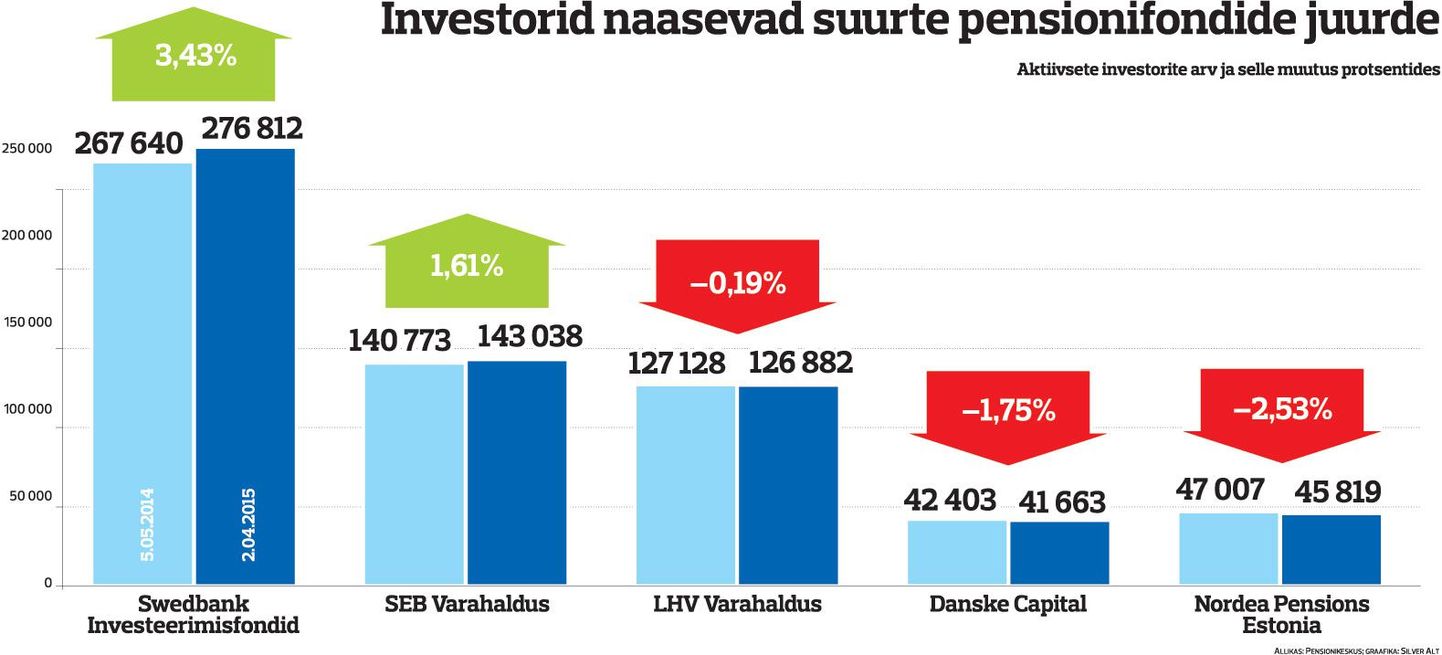
With LHV pension funds mightily grabbing market share of late, and those of Nordea a bit less mightily, this past year the biggies Swedbank and SEB have started to snatch it back.

With LHV pension funds mightily grabbing market share of late, and those of Nordea a bit less mightily, this past year the biggies Swedbank and SEB have started to snatch it back.
Pension Centre data says that, year-on-year (compared to last May, to be precise), SEB and Swedbank pension funds investors have increased 1.6 and a whopping 3.4 percent, respectively. As for all the rest, they shrunk somewhat.
As admitted by SEB Asset Management (Varahaldus) board member Sven Kunsing, they did better at the second pillar swap as in times before.
«Let’s not draw too far-reaching conclusions. We are just doing our job and, we may say, these past years it has borne fruit,» Mr Kunsing put it modest.
Last summer, Nordea pension funds took over those of Ergo. Even so, Nordea now has 2.5 percent less active investors than Ergo and Nordea put together, a year ago. According to Nordea Pensions Estonia AS chief Angelika Tagel, it is reasonable to compare the end of 2013 to the end of 2014, or some later date.
«Nordea assumed management of Ergo pension funds starting September 1st 2014, meaning that during eight months of 2014 customer loyalty of these funds was not for Nordea to guarantee,» explained Ms Tagel.
«The period also includes two swap dates out of three. Thus, a comparison of beginning and end of calendar year 2014 does not fully reflect pension funds and client relationship quality at Nordea,» she said.
Ms Tagel went on to say that the only time more people left Nordea funds was at the final swap opportunity in 2014, which was rather according to expectations regarding the developments last year.
«Reasons for customers leaving are not always financial by nature. In accumulation of pensions, clients are also influenced by convenience and other emotional aspects, on top of rational arguments,» underlined Ms Tagel.
Danske Capital CEO Silja Saar said they have shed about half thousand investors over the past 12 months. «For this, there were three reasons. Firstly, the number of clients that retire keeps increasing. Secondly, we have to observe the movement of clients between the various funds,» said Ms Saar.
According to her, throughout the years the results of Danske’s pension funds have stayed competitive, while the risk/gain ratio has been the best.
«Regrettably, not always the arguments cited to lure clients come with substance. For instance: with some clients, a fund’s historically high yield continues to works as a sales point,» bemoaned Ms Saar. «This, people perceive as promise of higher earnings in the future, but this has nothing to do with the future,» she said.
On top of that, Ms Saar cited Danske’s under average focus on young people who are the only new clients on the pension market.
In summer already, LHV begun to lose clients. For the first time in at least five years, LHV declined during the last swap-time but one, from August to November. As we know, second pillar funds can be swapped thrice a year and the swap-periods end in March, July and November.
LHV Asset Management CEO Mihkel Oja said that LHV’s investment strategy does markedly differ from that of the competitors – therefore, there are times they are beaten regarding yields.
«Over these past year and a half, out fund manager Andres Viisemann has been quite cautious when investing pension funds assets, because of doubts that there is more to be lost than gained,» explained Mr Oja.
«However, despite the lacklustre economic environment, share prices have edged upwards as buoyed by central banks monetary policy. Still, divergence between real economy and financial markets cannot grow forever. We do not believe that monetary policy can have significant impact on long-term economic growth. There comes the moment when one of the other must change direction. Andres Viisemann fears that the more the stock markets rise, the more they will eventually fall,» he said.
Observing the movement of investors between the funds of varying strategies, one detects that Danske and LHV have seen increase of investors in conservative strategy funds, while SEB and Swedbank have seen an increase with aggressive pension funds. Sven Kunsing says the switch from conservative to more risky comes for various reasons.
«One is definitely that people are a bit more aware of their options and are picking a fund more fitting to their risk profiles. The other (obviously smaller) reason may also be the realisation that in the current interest environment, it is basically no longer possible to make money with bonds (especially so in light of the investment limits set on conservative funds), and the best they can hope for is preservation of nominal value of investment,» said Mr Kunsing.
«This may have swayed some clients, traditionally more risk-averse, to set sights to higher-risk alternatives. And, thirdly, there are some examples of movements in the opposite direction – citing rise of risk assets for six years, they desire to cut that somewhat,» he explained.